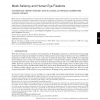Free Online Productivity Tools
i2Speak
i2Symbol
i2OCR
iTex2Img
iWeb2Print
iWeb2Shot
i2Type
iPdf2Split
iPdf2Merge
i2Bopomofo
i2Arabic
i2Style
i2Image
i2PDF
iLatex2Rtf
Sci2ools
TAP
2010
Springer
2010
Springer
Mesh saliency and human eye fixations
raction, simplification, segmentation, illumination, rendering, and illustration. Even though this technique is inspired by models of low-level human vision, it has not yet been validated with respect to human performance. Here, we present a user study that compares the previous mesh saliency approaches with human eye movements. To quantify the correlation between mesh saliency and fixation locations for 3D rendered images, we introduce the normalized chance-adjusted saliency by improving the previous chance-adjusted saliency measure. Our results show that the current computational model of mesh saliency can model human eye movements significantly better than a purely random model or a curvature-based model. Categories and Subject Descriptors: I.3.5 [Computer Graphics]: Computational Geometry and Object Modeling; I.3.m [Computer Graphics]: Perception General Terms: Algorithms, Human Factors, Verification Additional Key Words and Phrases: Visual perception, mesh saliency, eye-tracke...
Hardware | Human Eye Movements | Mesh | Mesh Saliency | TAP 2010 |
| Added | 30 Jan 2011 |
| Updated | 30 Jan 2011 |
| Type | Journal |
| Year | 2010 |
| Where | TAP |
| Authors | Youngmin Kim, Amitabh Varshney, David W. Jacobs, François Guimbretière |
Comments (0)

